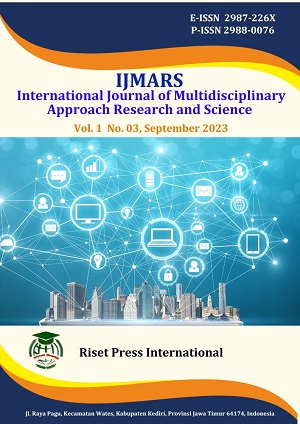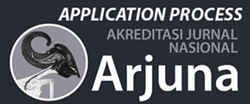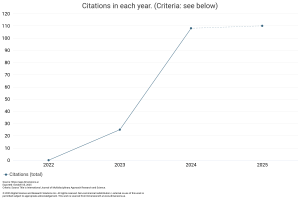Factors associated with the incidence of stunting in children aged 6-24 months in the Cileungsi area
DOI:
https://doi.org/10.59653/ijmars.v1i03.278Keywords:
Stunting, exclusive breast feeding, anemia, low birth weightAbstract
Stunting is a chronic malnutrition problem caused by a lack of nutritional intake over a long period of time, resulting in growth disorders, namely short children. This study aims to determine the factors associated with the incidence of stunting in toddlers aged 6-24 months in Cileungsi area. This method of research is a correlational study with a cross sectional approach. Sampling was carried out using non-probability sampling using total sampling. The sample in this study was 50 respondents in the Cileungsi area, namely mothers with toddlers aged 6-24 months who were willing to be respondents. Data was collected using interviews and height observations. The results showed that 56% of children aged 6-24 months experienced stunting (28 children), 3% (6 children) had low birth weight history, 14% (7 mothers) had hemoglobin levels during pregnancy is anemia, 56% did not receive exclusive breastfeeding (28 children). The results of the multivariate analysis showed that exclusive breastfeeding was the variable that had the significant relationship with the incidence of stunting in children aged 6-24 months in the Cileungsi area (p value = 0.000). Recommendations it is hoped that volunteer will always provide motivation, enthusiasm, education, and conduct home visits to the community regarding the importance of exclusive breastfeeding.
Downloads
References
Assaf, S., & Juan, C. (2020). Stunting and Anemia in Children from Urban Poor Environments in 28 Low and Middle-Income Countries. Nutrients, 12(3539), 5–8.
Devianto, A., Dewi, E. U., & Yustiningsih, D. (2022). Hubungan Tingkat Pengetahuan Ibu Tentang Stunting Dengan Angka Kejadian Stunting di Desa Sanggrahan Prambanan Klaten. Journal Nursing Research Publication Media (NURSEPEDIA), 1(2), 81–88. https://doi.org/10.55887/nrpm.v1i2.13
Halim, F., Ermiati, E., & Sari, E. A. (2021). Factors of Stunting in Toddlers: a Literature Review. Journal of Nursing Care, 4(1), 285–294. https://doi.org/10.24198/jnc.v4i1.27498
Ilmi Khoiriyah, H., Dewi Pertiwi, F., & Noor Prastia, T. (2021). Factors Associated with Stunting Incidents in Toddlers Aged 24-59 Months in Bantargadung Village, Sukabumi Regency in 2019. Promotor, 4(2), 145.
Indah, M. (2017). Kementerian Kesehatan Republik Indonesia. Kementerian Kesehatan RI, 1. https://www.depkes.go.id/article/view/18030500005/waspadai-peningkatan-penyakit-menular.html%0Ahttp://www.depkes.go.id/article/view/17070700004/program-indonesia-sehat-dengan-pendekatan-keluarga.html
Kemenkes. (2018). Mengenal Stunting dan Gizi Buruk. In Direktorat Promosi Kesehatan dan Pemberdayaan Masyarakat (p. 1).
Kiran, Y., & Dewi, U. S. P. (2017). Pengetahuan dan Sikap Perawat dalam Memenuhi Kebutuhan Psikologis dan Spiritual Klien Terminal. Jurnal Pendidikan Keperawatan Indonesia, 3(2), 182. https://doi.org/10.17509/jpki.v3i2.9425
Komalasari, K., Supriati, E., Sanjaya, R., & Ifayanti, H. (2020). Faktor-Faktor Penyebab Kejadian Stunting Pada Balita. Majalah Kesehatan Indonesia, 1(2), 51–56. https://doi.org/10.47679/makein.202010
Marlan Pangkong, A.J.M Rattu, N. S. . M. (2017). HUBUNGAN ANTARA PEMBERIAN ASI EKSKLUSIF DENGAN KEJADIAN STUNTING PADA ANAK USIA 13-36 BULAN DI WILAYAH KERJA PUSKESMAS SONDER PENDAHULUAN Gizi merupakan salah satu faktor yang menentukan tingkat kesehatan dan ( Kepmenkes RI , 2013 ). Pencapaian ASI eksklu. https://ejournal.unsrat.ac.id/index.php/kesmas/article/view/23065
Ninda, S., Putri, A., & Taufan, J. (2021). Permasalahan Dalam Pembelajaran Selama Pandemi Covid-19 Bagi Anak Berkebutuhan Khusus. Jurnal Penelitian Pendidikan Khusus, 9(2), 41–45. http://ejournal.unp.ac.id/index.php/jupekhu/article/view/112223
Oktaviani, Ni Putu Wiwik, Sanya Anda Lusiana, Taruli Rohana Sinaga, RohaniRetnauli Simanjuntak, Stephanie Lexy Louis, Rininta Andriani, Noviyati Rahardjo Putri, Ayu Nina Mirania, Laela Nur Rokhmah, and Ira Kusumawati. 2022. Siaga Stunting Di Indonesia.
Rahayu, A., Yulidasari, F., Putri, A. O., Rahman, F., & Rosadi, D. (2016). Faktor Risiko Yang Berhubungan Dengan Kejadian Pendek Pada Anak Usia 6-24 Bulan. Jurnal Kesehatan Masyarakat, 11(2), 96–103.
Sari, N., Manjorang, M. Y., Zakiyah, & Randell, M. (2021). Exclusive breastfeeding history risk factor associated with stunting of children aged 12–23 months. Kesmas, 16(1), 28–32. https://doi.org/10.21109/KESMAS.V16I1.3291
Sistem informasi Direktorat Gizi Masyarakat Kemkes. (n.d.).
Tanzil, L., & Hafriani, H. (2021). Faktor-Faktor Yang Mempengaruhi Terjadinya Stunting Pada Balita Usia 24-59 Bulan. Jurnal Kebidanan Malahayati, 7(1), 25–31. https://doi.org/10.33024/jkm.v7i1.3390
Tim Nasional Percepatan Penanggulangan Kemiskinan. (2020). Wapres Pimpin Rapat TNP2K Bahas Target Penurunan Kemiskinan dan Stunting 2024. Tnp2k.Go.Id.
WHO. (2012). Anaemia Policy Brief. 6, 1–7. http://www.who.int//iris/bitstream/10665/148556/1/WHO_NMH_NHD_14.4_eng.pdf
Downloads
Published
How to Cite
Issue
Section
Categories
License
Copyright (c) 2023 Murtiningsih Murtiningsih, Lia Fitriani, Desty Ayu Pratama Putri

This work is licensed under a Creative Commons Attribution-ShareAlike 4.0 International License.
Authors who publish with this journal agree to the following terms:
- Authors retain copyright and grant the journal right of first publication with the work simultaneously licensed under a Creative Commons Attribution-ShareAlike that allows others to share the work with an acknowledgement of the work's authorship and initial publication in this journal.
- Authors are able to enter into separate, additional contractual arrangements for the non-exclusive distribution of the journal's published version of the work (e.g., post it to an institutional repository or publish it in a book), with an acknowledgement of its initial publication in this journal.
- Authors are permitted and encouraged to post their work online (e.g., in institutional repositories or on their website) prior to and during the submission process, as it can lead to productive exchanges, as well as earlier and greater citation of published work (See The Effect of Open Access).
























